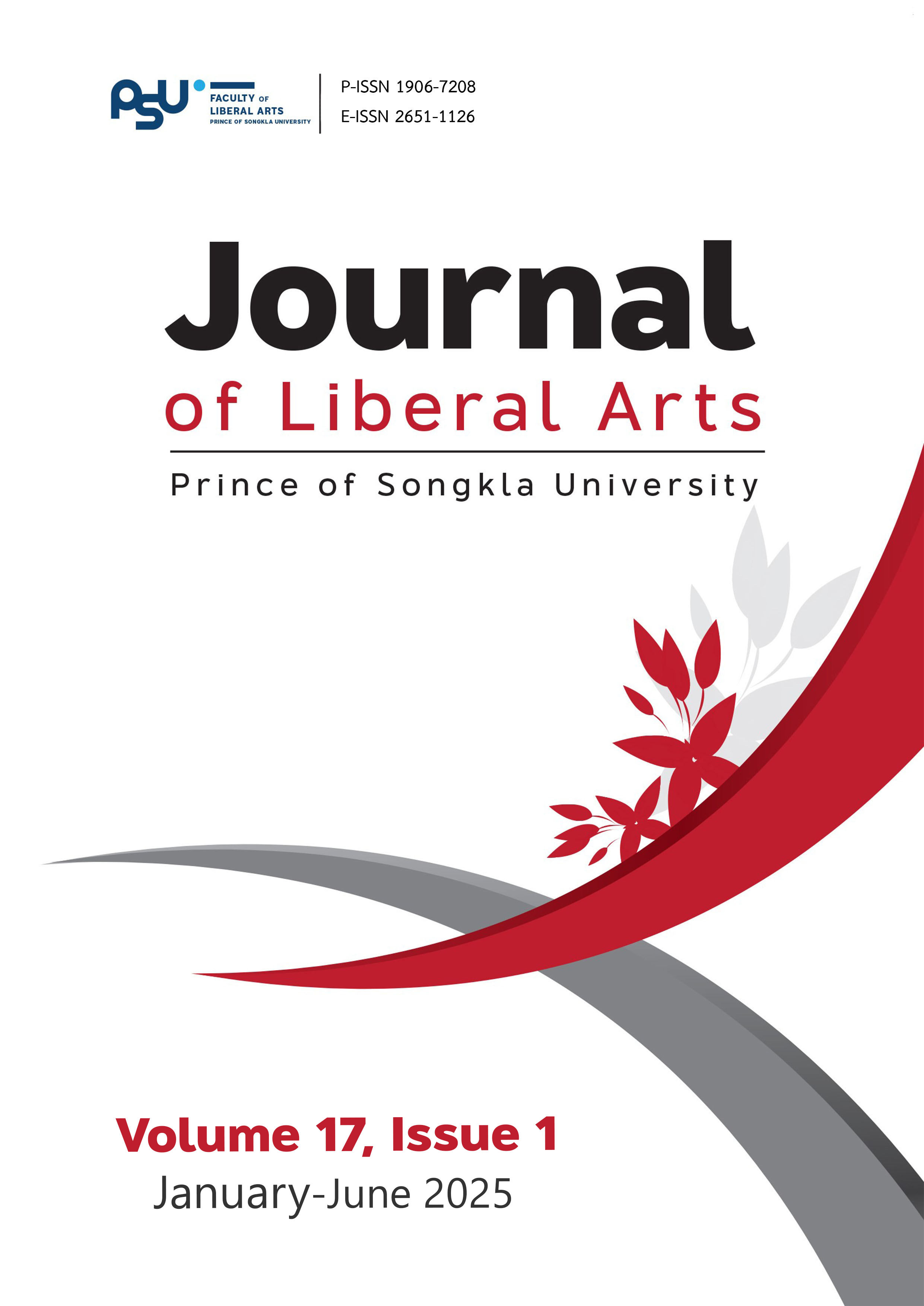The Use of Teaching Proficiency through Reading and Storytelling (TPRS) to Promote English Reading Aloud of Young Learners
DOI:
https://doi.org/10.14456/jlapsu.2025.5Keywords:
Teaching Proficiency through Reading and Storytelling (TPRS), English reading aloud, StorytellingAbstract
The objectives of this research were: 1) to examine the effects of Teaching Proficiency through Reading and Storytelling (TPRS) on second-grade students' English reading aloud, and 2) to study students’ opinions about learning English using TPRS. The samples were six second-grade students at Ban E-Tom School, Kanthararom District, Sisaket Province. They were selected by using cluster random sampling. The research instruments were the two lesson plans based on TPRS, an English reading aloud test, a questionnaire, and a semi-structured interview. The data were analyzed to test the normal distribution of the pre-test and post-test using the K-S test. Mean (X̅), Standard Deviation (S.D), and t-test for a dependent sample were also used. The results revealed that the post-test mean score (X̅=9.67, S.D. = 1.86) of the English reading-aloud of the participants who learned English using TPRS was significantly higher than the pre-test one (X̅=5.17, S.D. = 1.33) at the .05 level. Moreover, the participants had positive opinions towards learning English using TPRS. Most students strongly agreed that the learning activities made them enjoy learning English (X̅ = 4.83, S.D. = 0.41), and most students agreed that learning English through the lessons can improve their English reading aloud (X̅ = 4.00, S.D. = 0.63) as well. The findings of the individual semi-structured interview revealed that the students enjoyed the lesson and increased their confidence in reading aloud. This study showed that learning English using TPRS could effectively improve second-grade students’ English reading aloud.
References
Acosta-Tello, E. (2019). Reading aloud: Engaging young children during a read aloud experience. Research in Higher Education Journal, 37, 1-7. Retrieved from https://files.eric.ed.gov/fulltext/EJ1233113.pdf
Adams, M. J. (1994). Beginning to read: Thinking and learning about print. MIT Press.
Asher, J. J. (1969). The Total Physical Response Approach to Second Language Learning. The Modern Language Journal, 53(1), 3–17. https://doi.org/10.2307/322091
Baker, D. L., Santoro, L., Biancarosa, G., Baker, S. K., Fien, H., & Otterstedt, J. (2020). Effects of a read-aloud intervention on first-grade student vocabulary, listening comprehension, and language proficiency. Reading and Writing, 33(10), 2697-2724. https://doi.org/10.1007/s11145-020-10060-2
Batini, F., Bartolucci, M., & Timpone, A. (2018). The effects of reading aloud in the primary school. Psychology and education, 55(1-2), 111-122. Retrieved from https://www.researchgate.net/publication/325486900
Cicerchia, M. (2022). 3 Commons reading problems for students. Touch-type Read & Spell (TTRS). Retrieved November 23, 2022, from https://www.readandspell.com/ common –reading -problems
Çimen, B. A., & Çeşme, H. (2022). The impact of total-physical-response storytelling on EFL learners' speaking anxiety and self-assessed speaking skills. International Journal of Language Academy, 10(2), 232-247. http://dx.doi.org/10.29228/ijla.62630
Fagertun, C. (2020). A case study of TPRS and reading aloud as teaching methods in an elementary school in Sweden [Unpublished doctoral dissertation]. University of Gävle.
Gao, J. (2022). Cooperative language learning in teaching proficiency through reading and storytelling. Chinese Language Teaching Methodology and Technology, 5(2), 1-12. Retrieved from https://engagedscholarship.csuohio.edu/cltmt/vol5/iss2/2
Håland, A., Hoem, T. F., & McTigue, E. M. (2021). The quantity and quality of teachers’ self-perceptions of read-aloud practices in Norwegian first-grade classrooms. Early Childhood Education Journal, 49, 1-14. https://doi.org/10.1007/s10643-020-01053-5
Kara, K., & Eveyik-Aydin, E. (2019). Effects of TPRS on very young learners’ vocabulary acquisition. Advances in Language and Literary Studies, 10(1), 135-146. https://doi.org/10.7575/aiac.alls.v.10n.1p.135
Krashen, S. D., & Terrell, T. (1983). Natural approach. Pergamon.
Lane, H. B., & Wright, T. L. (2007). Maximizing the effectiveness of reading aloud. The Reading Teacher, 60(7), 668-675. https://doi.org/10.1598/RT.60.7.7
Luoma, S. (2004). Speaking tasks. In J. C. Alderson, L. F. Bachman (Eds.), Assessing speaking (pp. 29-58). Cambridge University Press.
Ministry of Education. (2008). The basic education core curriculum B.E. 2551 (A.D. 2008).The Express Transportation Organization of Thailand. http://academic.obec.go.th/images/document/1525235513_d_1.pdf
Moats, L. C. (1998). Teaching decoding. American Educator, 22(1), 42-49. Retrieved from https://citeseerx.ist.psu.edu/document?repid=rep1&type=pdf&doi=e8881a3694e3201ba30c693be871ee48aeccacff
Nugraha, M. A. (2021). The Use of Teaching Proficiency through Reading and Storytelling (TPRS) in Teaching Speaking Skills. JEPAL (Journal of English Pedagogy and Applied Linguistics), 2(1), 42-54. https://doi.org/10.32627/jepal.v2i1.58
Ponguagoon, P., & Lornklang, T. (2022). The use of teaching proficiency through reading and storytelling (TPRS) to promote vocabulary learning achievement of fourth-grade students. Ratchaphruek Journal, 20(3), 89-100. https://doi.org/10.14456/rpjnrru.2022.22
Prastikawati, E. F. (2018). TPR-Storytelling as a communicative friendly English teaching and learning for children [Paper Session]. The 2nd International Conference on Child-Friendly Education (ICCE), Central Java: Muhammadiyah University of Surakarta.
Rasinski, T. V., & Smith, M. C. (2018). The Megabook of fluency. Scholastic. Retrieved December 14, 2022, from https://teacher.scholastic.com/education/pdfs/Megabook-Intro.pdf
Ray, B., & Seely, C. (2005). Fluency through TPR Storytelling: Achieving real language acquisition in school (4th ed). Command Performance Language Institute.
Roney, R. C. (1996). Storytelling in the classroom: some theoretical thoughts. Storytelling world, 9, 7-9. Retrieved from https://files.eric.ed.gov/fulltext/ED405589.pdf
Senawati, J., Suwastini, N. K. A., Jayantini, I. G. A. S. R., Adnyani, N. L. P. S., & Artini, N. N. (2021). The benefits of reading aloud for children: A review in EFL context. Indonesian Journal of English Education, 8(1), 80-107. http://doi.org/10.15408/ijee.v1i1.19880
Snow, C. E., Burns, M. S., & Griffin, P. (Eds.). (1998). Preventing reading difficulties in young children. National Academy Press.
Utami, W. N., Muin, A., & Suaidi, A. (2023, November 7-8). Enhancing students’ vocabulary skills using teaching proficiency through reading and storytelling (TPRS) method [Paper presentation]. 2nd Annual International Conference on Islamic Education and Language (AICIEL) 2023, Banten, Indonesia. Retrieved from https://ftk.uinbanten.ac.id/journals/index.php/aiciel/article/view/9717
Downloads
Published
How to Cite
Issue
Section
License
Copyright (c) 2025 Thanchanok Manchakapate, Thanachart Lornklang

This work is licensed under a Creative Commons Attribution-NonCommercial-NoDerivatives 4.0 International License.
The authors retain the copyright to their article but the Journal of Liberal Arts, Prince of Songkla University reserves the exclusive rights to first publication.






